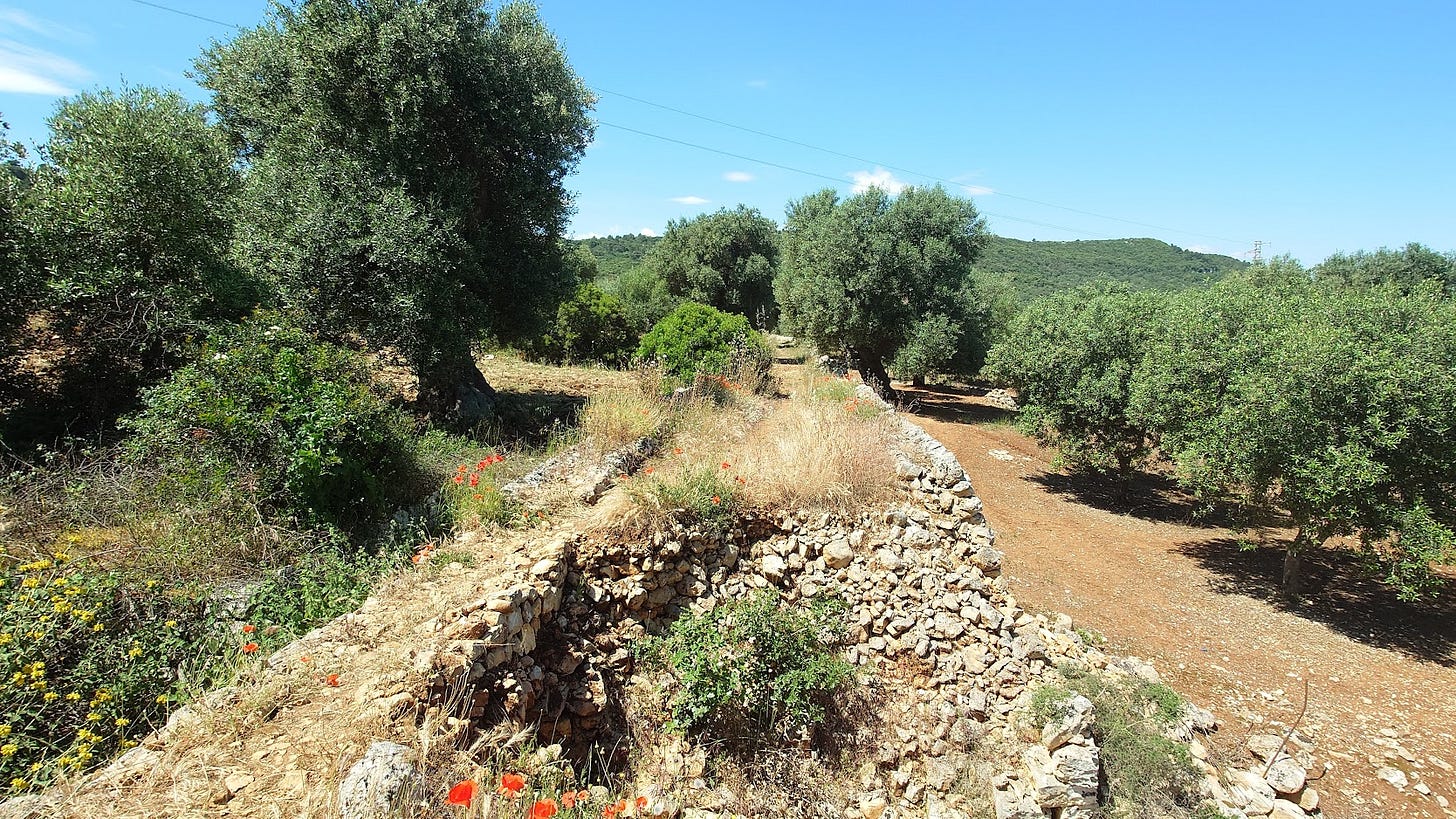Puglia’s rich traditions & fragile future: Culture, cuisine, and olives under threat
Last month, I visited Puglia to look at olives and learn how they are being affected by disease and climate change
🌱 I'm Sally Morgan, an organic gardener and botanist who loves to experiment. Here you can read about matters relating to climate change, sustainability, organic gardening, growing veg and biodiversity, helping you to become a
climate savvy gardener 🌱☀️🌧️❄️🌡️
Resilience 7
This month the post is long (sorry) so I have combined the weekly free post and the monthly Resilience so free subscribers will be able to read much of it.
As a foodie, I have long wanted to visited Puglia - the region that forms the heel of Italy. Here agriculture dominates the landscape: endless olive groves, fields of durum wheat, fava beans, grazing sheep, plus lots of wild flowers. The cuisine is simple and rustic, yet delicious.
Last month, I finally managed a visit - a walking and cultural tour. Our small group wandered through olive groves and wheat fields, admired the wildflowers and explored the stunning towns of Alberobello, Ostuni, and Matera, But what I was most eager to see were the olive trees.
To begin, here’s a gallery of images from the trip to give you a taste of the landscape and culture: the cone-shaped Trulli houses of Alberobello; the dazzling white buildings of Ostuni; the historic charm of Polignano a Mare and the unforgettable Matera, which lies just over the border in Basilicata and famously featured in the The Passion of the Christ and the opening scenes of the latest James Bond film, A Time To Die. Matera is a UNESCO World Heritage Site due to its ancient cave dwellings, the sassi, that form a labyrinth of homes, churches, and cisterns which have been hollowed from the limestone cliffs. If you are ever in the area, this town is a must-visit location.
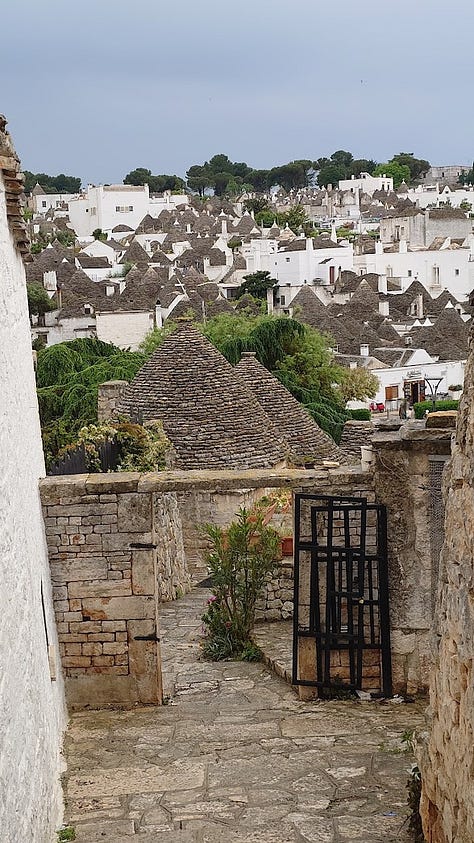
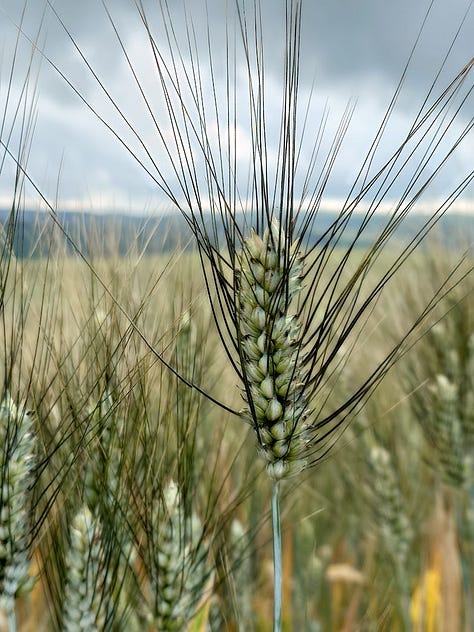
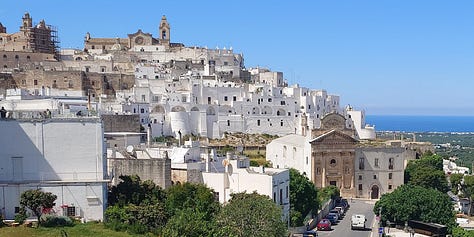
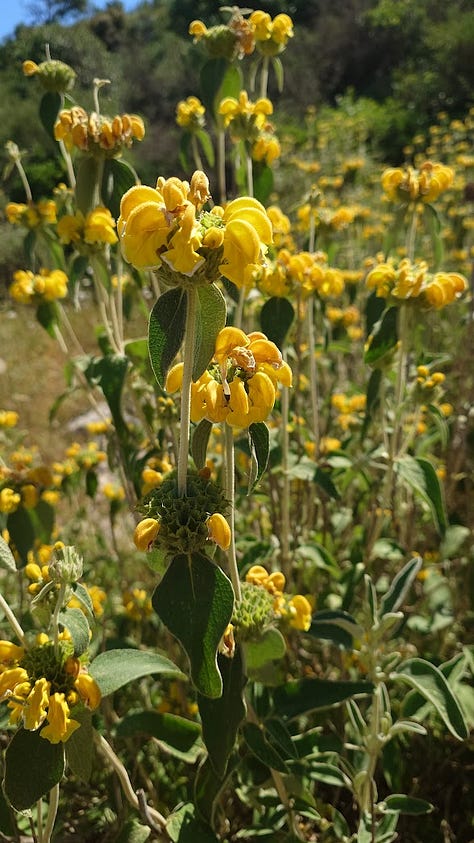
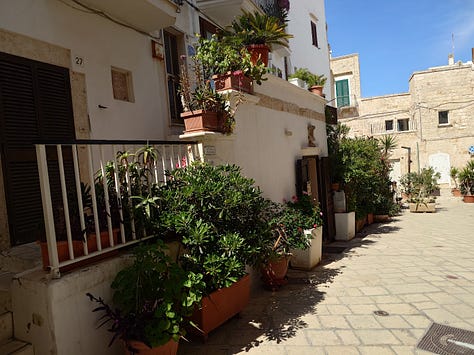

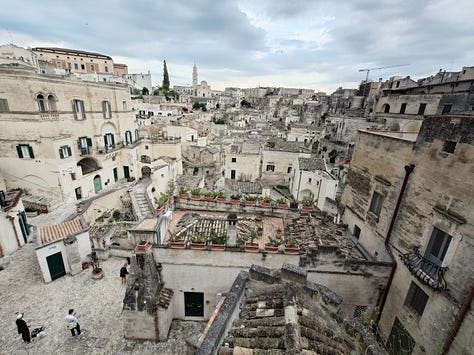
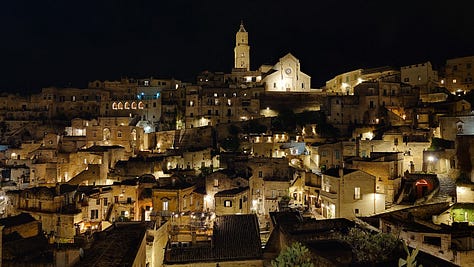
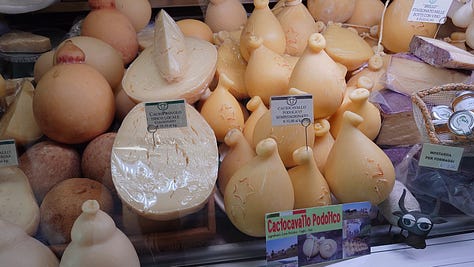
Lampascioni
Before I delve into olives, I will mention one local delicacy - lampascioni - the edible bulbs of the tassel hyacinth (Muscari comosum), which is common in the area. The flower spike bears blue flowers, while the bulb is a pale pinky red. The bulbs are foraged and sold in local markets.
Cooked lampascioni appeared on a plate of antipasti one evening, along with fave e cicoria (pureed fava bean and chicory), stuffed peppers and local bread made from durum wheat. The bulbs have to be cleaned, trimmed, boiled until tender, then either mixed with olive oil and seasoned, sauté or fried. I was keen to try them but found them slightly bitter and dry, so can’t say I was wild about them!
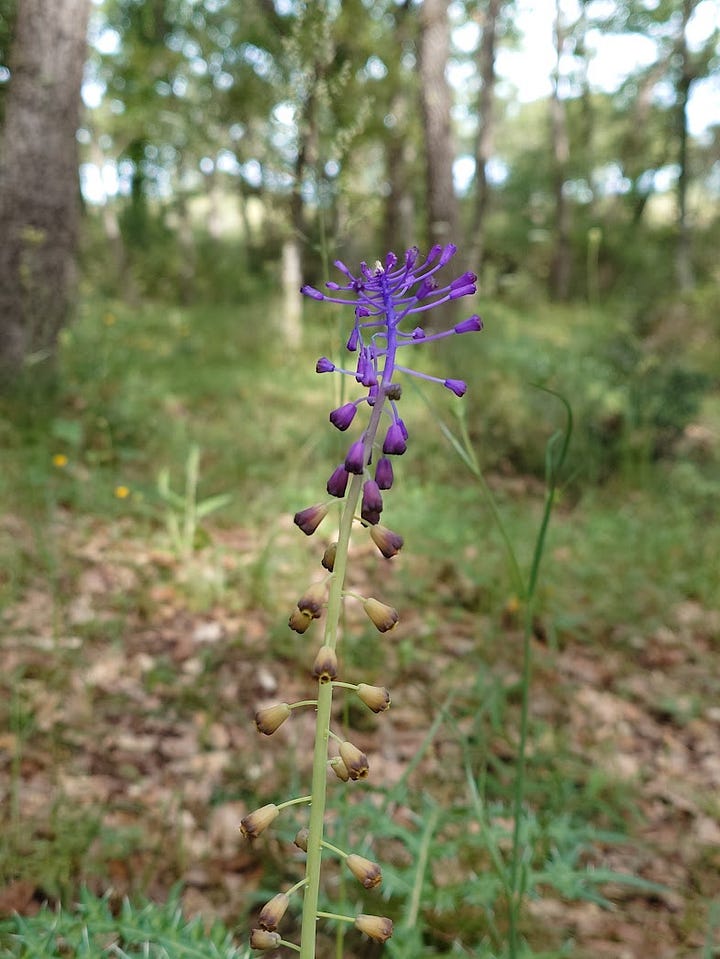
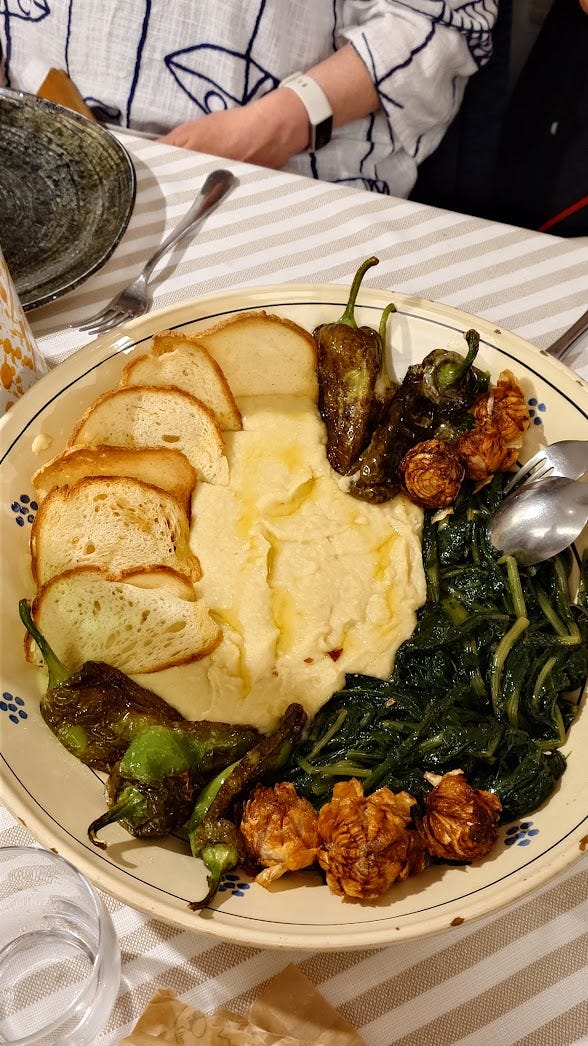
Olive oil from Puglia
Olive oil offers a remarkable spectrum of flavours, shaped by the different varieties of olive trees, the terroir, and timing of the harvest. Oil pressed from early season green olives tends to be bold, bitter, and tangy, while oil from the fully ripened black olives is typically milder, with more savoury and rounded notes.
Some of the best olive oil comes from Puglia where there are groves of ancient trees that date back to Roman times. The soils, climate and landscape all suit the growing of olives, and as a result, Puglia produces almost half of Italy’s output. The oil is noted for its complex fruity, slightly bitter and spicy flavours, often with a hint of artichoke.
But there are dark clouds on the horizon. My olive story starts with a piece written by one of my fellow travellers who you can follow here on Substack, @thehumanside1
“It’s May, and the early afternoon sun is dappling the skin on my elbow, as the olive tree above sways in the breeze. I can hear bird song, and the occasional bee, buzzing between spring flowers. Sitting up, I am in the grounds of an ancient Masseria, an Italian olive farm. The slopes around me are covered with olive trees, extending as far as the eye can see to the east, where the deep blue sky touches the sea, and to the west, to the tops of the hills. This is an ancient place, and the life lived in these hills has been, in some ways, unchanged for 1000s of years, but even as I lie, peacefully enjoying an idyllic spring day, all is not quite as it should be. The shadow dappling my forearm is smaller than it once was, the ancient tree cut back, and grafted with smaller, new branches.
Puglia is preparing to join the war to the south, building its defences ahead of the relentless, slow advance of disease. The war will certainly come this way soon, and the small preparations that are made may help, but the benefits of such preparations are uncertain, and, for now at least, the landscape and the people live today and brace for what’s to come. Certainly the view I see today is unlikely to be the same when the next spring flowers come, and even the most ancient of the olive trees, which have seen two world wars, will be gone forever.” thehumanside
2013 was a landmark year in Puglia for all the wrong reasons. It was the year that Xylella fastidiosa arrived in the Puglian olive groves. This is a bacterium, and it causes Olive Quick Decline Syndrome, a wasting disease. The bacteria block the xylem vessels that run from root to shoot, carrying vital water and nutrients and this results in leaf scorch, desiccation, die-back and death. Since 2013, more than 21 million olive trees have been lost to the disease or cleared to stop its spread.
Xylella is native to the Americas, where it affects crops such as coffee, citrus and grapevines, and since its arrival in Puglia, it has spread to other parts of Italy, France, Spain, and Greece. It can infect many different types of plants, not just olives – more than 500 are listed as being affected – the main economic plants being olive, citrus, coffee, grapevines, and Prunus species, but it will also infect lavender, oleander, rosemary, cistus, cytisus, genista, hebe, plus trees such as elm, maple, oak and more.
The bacteria require a vector to transport them from plant to plant. In this case, its an insect that feeds on the sap in the xylem vessels, the most common vector being the meadow spittlebug or froghopper. Once infected, the insect carries the bacteria for life.
… . and there is no cure
EU regulations to contain the disease involve pesticide spraying to kill any vectors and then clearing of all olives, healthy or otherwise within a 50m radius of an infected tree, plus a further 400m zone of sampling and then a 2.5km buffer zone. Despite these measures, the disease has has spread 250 km north through Puglia, helped by the vector being moved by vehicles and trains, so it can jump large distances, as well as be carried on the wind.
But farmers are beginning to question these containment protocols, as there is increasing evidence that environment factors have more of a role to play than the bacterium. With millions of trees lost and many others under threat, including some of the oldest olives in existence, farmers are looking for answers.
Other factors at play
A research paper published last year raised the possibility that Olive Quick Decline Syndrome may not always be caused by Xylella, but the environment may be playing a role. Marco Scortichini, the lead researcher for olives and fruit crops at the Italian Council for Agricultural Research and Economics and co-author of the paper, said:
“The past decade has seen a shift from the notion of a single pathogen causing fatal disease in trees to a more complex understanding. We’re gradually recognising that various microbes, influenced by temperature fluctuations and climatic disruptions, can collectively lead to disease.”
The researchers were expecting lots of bacteria in trees growing in infected areas, but less than a quarter of the trees killed by the disease were actually infected by the bacterium. It would seem from this research that Xylella is not always the primary cause of the syndrome – these findings are, of course, rather controversial given the investment in combatting the disease, and replanting of groves with resistant varieties etc.
Trees with symptoms were able to transmit the disease to an average of 19 other trees in a year, but those trees with no symptoms had very low infectivity, so why fell all trees up to 50m around an infected tree? The researchers suggest that the rule requiring the uprooting of all host plants that surround one Xylella-positive tree within a radius of 50m should be abandoned to save many healthy centennial and monumental olive trees and the remarkable landscape in which they live.
So what else can farmers do?






